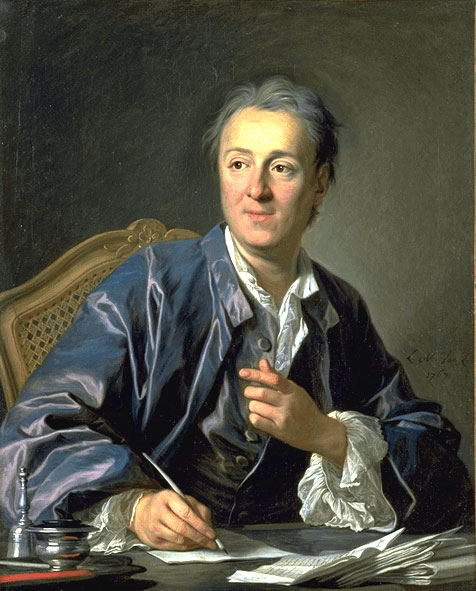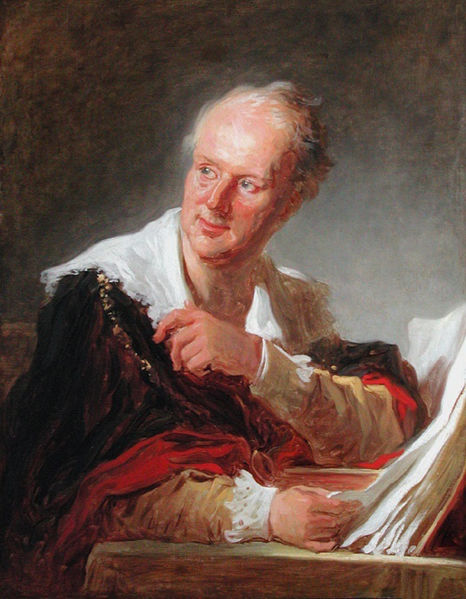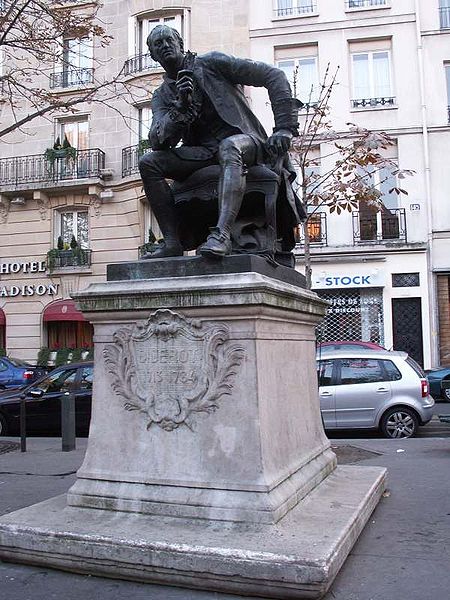<Back to Index>
- Philosopher Denis Diderot, 1713
- Painter Francesco Lazzaro Guardi, 1712
- 1st President of the Czech Republic Václav Havel, 1936



Denis Diderot (October 5, 1713 – July 31, 1784) was a French philosopher, art critic, and writer. He was a prominent figure during the Enlightenment and is best-known for serving as chief editor of and contributor to the creation of the Encyclopédie.
Diderot also contributed to literature, notably with Jacques le fataliste et son maître (Jacques the Fatalist and his Master), which emulated Laurence Sterne in challenging conventions regarding novels and their structure and content, while also examining philosophical ideas about free will. Diderot is also known as the author of the dialogue, Le Neveu de Rameau (Rameau's Nephew),
upon which many articles and sermons about consumer desire have been
based. His articles included many topics of the Enlightenment. Denis Diderot was born in the eastern French city of Langres and commenced his formal education in the Lycée Louis le Grand.
In 1732, he earned a master of arts degree in philosophy. He abandoned
the idea of entering the clergy and decided instead to study law. His
study of law was short-lived; in 1734, Diderot decided instead to
become a writer. Because of his refusal to enter one of the learned
professions, he was disowned by his father, and for the next ten years
he lived a rather bohemian existence. In 1742, he befriended Rousseau. Then in 1743, he further alienated his father by marrying Antoinette Champion,
a devout Roman Catholic. The match was considered inappropriate due to
Champion's low social status, poor education, fatherless status, lack
of a dowry, and – at thirty-two – being four years his senior. The
marriage
produced one surviving child, a girl. Her name was Angélique,
after both Diderot's dead mother and sister. The death of his sister, a
nun, from overwork in the convent may have affected Diderot's opinion
of religion. She is assumed to have been the inspiration for his novel
about a nun, La Religieuse,
in which he depicts a woman who is forced to enter a monastery, and
suffers at the hands of the other nuns in the community. He had affairs
with the writer Madame Puisieux and with Sophie Volland. His letters to Sophie Volland contain
some of the most vivid of all the insights that we have of the daily
life of the philosophic circle of Paris during this time period. Though
his work was broad and rigorous, it did not bring him riches. He
secured none of the posts that were occasionally given to needy men of
letters; he could not even obtain the bare official recognition of
merit which was implied by being chosen a member of the Académie française. When the time came for him to provide a dowry for his daughter, he saw no alternative than to sell his library. When Catherine II of Russia heard
of his financial troubles she commissioned an agent in Paris to buy the
library. She then requested that the philosopher retain the books in
Paris until she required them, and act as her librarian with a yearly
salary. In 1773 and 1774, Diderot spent some months at the empress's
court in Saint Petersburg. Diderot died of gastro-intestinal problems in Paris on July 31, 1784, and was buried in the city's Église Saint-Roch. His heirs sent his vast library to Catherine II, who had it deposited at the National Library of Russia. Diderot's earliest works included a translation of Temple Stanyan's History of Greece (1743); with two colleagues, François-Vincent Toussaint and Marc-Antoine Eidous, he produced a translation of Robert James' Medical Dictionary (1746–1748); at about the same time he published a free rendering of Shaftesbury's Inquiry Concerning Virtue and Merit (1745), with some original notes of his own. In 1746, he wrote his first original work: the Pensées philosophiques, and he added to this a short complementary essay on the sufficiency of natural religion. He then composed a volume of bawdy stories, Les bijoux indiscrets (1748); in later years he repented this work. In 1747, he wrote the Promenade du sceptique, an allegory pointing
first at the extravagances of Catholicism; second, at the vanity of the
pleasures of the world which is the rival of the church; and third, at
the desperate and unfathomable uncertainty of the philosophy which
professes to be so high above both church and world. Diderot's celebrated Lettre sur les aveugles ("Letter
on the Blind") (1749), introduced him to the world as a daringly
original thinker. The subject is a discussion of the interrelation
between man's reason and the knowledge acquired through perception (the five senses).
The title, "Letter on the Blind For the Use of Those Who See" also
evoked some ironic doubt about the who exactly were "the blind" under
discussion. In the essay, a blind English mathematician named
Saunderson argues that since knowledge derives from the senses, then
mathematics is the only form of knowledge that both he and a sighted
person can agree about. It is suggested that the blind could be taught
to read through their sense of touch (a later essay, Lettre sur les sourds et muets, considered the case of a similar deprivation in the deaf and mute). What makes the Lettre sur les aveugles so remarkable, however, is its distinct, if undeveloped, presentation of the theory of variation and natural selection. After
signing a letter of submission and promising never to write anything
prejudicial against religion ever again (with the result that from then
on his most controversial works were henceforth published only after
his death), Diderot was released from the dungeons of the Vincennes fortress after three months. In collaboration with d'Alembert, he subsequently embarked on his greatest project, The Encyclopédie, ou dictionnaire raisonné des sciences, des arts et des métiers. André Le Breton, a bookseller and printer, approached Diderot with a project for the publication of a translation of Ephraim Chambers' Cyclopaedia, or Universal Dictionary of Arts and Sciences into French, first undertaken by the Englishman John Mills,
and followed by the German Gottfried Sellius. Diderot accepted the
proposal. During this translation his creative mind and astute vision
transformed the work. Instead of a mere reproduction of the Cyclopaedia,
he persuaded Le Breton to enter upon a new work, which would collect
all the active writers, ideas, and knowledge that were moving the
cultivated class of the Republic of Letters to
its depths; however, they were comparatively ineffective due to their
lack of dispersion. His enthusiasm for the project was transmitted to
the publishers; they collected a sufficient capital for a more vast
enterprise than they had first planned. Jean le Rond d'Alembert was persuaded to become Diderot's colleague. In
1750 an elaborate prospectus announced the project to a delighted
public, and in 1751 the first volume was published. This work was very
unorthodox and had many forward thinking ideas for the time. Diderot
stated within this work, "An encyclopedia ought to make good the
failure to execute such a project hitherto, and should encompass not
only the fields already covered by the academies, but each and every
branch of human knowledge." Upon encompassing every branch of knowledge
this will give, "the power to change men's common way of thinking."
This idea was profound and intriguing, as it was one of the first works
during the Enlightenment. Diderot wanted to give all people the ability
to further their knowledge and, in a sense, allow every person to have
any knowledge they sought of the world. The work, implementing not only
the expertise of scholars and Academies in their respective fields but
that of the common man in their proficiencies in their trades, sought
to bring together all knowledge of the time and condense this
information for all to use. These people would amalgamate and work
under a society to perform such a project. They would work alone to
shed societal conformities, and build a multitude of information on a
desired subject with varying view points, methods, or philosophies. He
emphasized the vast abundance of knowledge held within each subject
with intricacies and details to provide the greatest amount of
knowledge to be gained from the subject. All people would benefit from
these insights into different subjects as a means of betterment;
bettering society as a whole and individuals alike. This message under the Ancien Régime would
severely dilute the regime's ability to control the people. Knowledge
and power, two key items the upper class held over the lower class,
were in jeopardy as knowledge would be more accessible, giving way to
more power amongst the lower class. An encyclopedia would give the
layman an ability to reason and use knowledge to better themselves;
allowing for upward mobility and increased intellectual abundance
amongst the lower class. A growth of knowledge amongst this segment of
society would provide power to this group and a yearning to question
the government. The numerated subjects in the folios were
not just for the good of the people and society, but were for the
promotion of the state as well. The state did not see any benefit in
the works, instead viewing them as a contempt to contrive power and
authority from the state. Diderot's
work was plagued by controversy from the beginning; the project was
suspended by the courts in 1752. Just as the second volume was
completed accusations arose, regarding seditious content, concerning
the editors entries on religion and natural law. Diderot was detained
and his house was searched for manuscripts for subsequent articles. But
the search proved fruitless as no manuscripts could be found. They were
hidden in the house of an unlikely confederate – Chretien de Lamoignon Malesherbes,
the very official who ordered the search. Although Malesherbis was a
staunch absolutist - loyal to the monarchy, he was sympathetic to the
literary project. Along with his support, and that of other well-placed
influential confederates, the project resumed. Diderot returned to his
efforts only to be constantly embroiled in controversy. These
twenty years were to Diderot not merely only a time of incessant
drudgery, but harassing persecution and desertion of friends. The
ecclesiastical party detested the Encyclopédie,
in which they saw a rising stronghold for their philosophic enemies. By
1757 they could endure it no longer. The subscribers had grown from
2,000 to 4,000, a measure of the growth of the work in popular
influence and power. The Encyclopédie threatened the governing social classes of France (aristocracy) because it took for granted the justice of religious tolerance, freedom of thought,
and the value of science and industry. It asserted the doctrine that
the main concern of the nation's government ought to be the nation's
common people. It was believed that the Encyclopédie was
the work of an organized band of conspirators against society, and that
the dangerous ideas they held were made truly formidable by their open
publication. In 1759, the Encyclopédie was
formally suppressed. The decree did not stop the work, which went on,
but its difficulties increased by the necessity of being clandestine. Jean le Rond d'Alembert withdrew from the enterprise and other powerful colleagues, including Anne Robert Jacques Turgot, Baron de Laune, declined to contribute further to a book which had acquired a bad reputation. Diderot
was left to finish the task as best he could. He wrote several hundred
articles, some very slight, but many of them laborious, comprehensive,
and long. He damaged his eyesight correcting proofs and editing the
manuscripts of less competent contributors. He spent his days at
workshops, mastering manufacturing processes, and his nights writing
what he had learned during the day. He was incessantly harassed by
threats of police raids. The last copies of the first volume were
issued in 1765. At the last moment, when his immense work was drawing
to an end, he encountered a crowning mortification: he discovered that
the bookseller, fearing the government's displeasure, had struck out
from the proof sheets, after they had left Diderot's hands, all
passages that he considered too dangerous. The monument to which
Diderot had given the labor of twenty long and oppressive years was
irreparably mutilated and defaced. It was 12 years, in 1772, before the
subscribers received the final 27 folio volumes of the Encyclopédie, ou dictionnaire raisonné des sciences, des arts et des métiers since the first volume had been published. Although the Encyclopédie was
Diderot's monumental piece, he was the author of many other works that
sowed nearly every field of intellectual interest with new and creative
ideas. He wrote sentimental plays, Le Fils naturel (1757) and Le Père de famille (1758), accompanying them with essays on theatrical theory and practice, including Les Entretiens sur Le Fils naturel (Conversations on Le Fils naturel), in which he announced the principles of a new drama — the serious, domestic, bourgeois drama of real life, in opposition to the stilted conventions of the classical French stage. His art criticism was also highly influential. Diderot's Essais sur la peinture was described by Johann Wolfgang von Goethe,
as "a magnificent work, which speaks even more helpfully to the poet
than to the painter, though to the painter too it is as a blazing
torch." Diderot's most intimate friend was the philologist Friedrich Melchior Grimm. They were brought together by their friend in common at that time, Jean-Jacques Rousseau.
Grimm wrote newsletters to various high personages in Germany,
reporting the happenings of art and literature in Paris, then the
intellectual capital of Europe. Diderot helped Grimm between 1759 and
1779, by writing an account of the annual exhibitions of paintings in
the Paris Salon. These reports are highly readable pieces of art criticism. According to Charles Augustin Sainte-Beuve,
they initiated the French into a new way of laughing, and introduced
people to the mystery and purport of colour by ideas. "Before Diderot," Anne Louise Germaine de Staël wrote,
"I had never seen anything in pictures except dull and lifeless
colours; it was his imagination that gave them relief and life, and it
is almost a new sense for which I am indebted to his genius." Jean-Baptiste Greuze was Diderot's favorite contemporary artist. Greuze's most characteristic pictures were the rendering in colour of the same sentiments of domestic virtue and the pathos of common life, which Diderot had attempted to represent upon the stage. Diderot
was above all things interested in the life of individuals. He did not
care about the abstract life of the race, but the incidents of
individual character, the fortunes of a particular family, the
relations of real and concrete motives in this or that special case. He
was delighted with the enthusiasm of a born casuist in curious puzzles of right and wrong, and in devising a conflict between the generalities of ethics and the conditions of an ingeniously contrived practical dilemma. Diderot's interest expressed itself in didactic and sympathetic form. However, in two of his most remarkable pieces, this interest is not sympathetic, but ironic. Jacques le fataliste (written in 1773, but not published until 1792 in German and 1796 in French) is similar to Tristram Shandy and The Sentimental Journey. His dialogue Le Neveu de Rameau (Rameau's Nephew) is a "farce-tragedy" reminiscent of the Satires of Horace. A favorite classical author of Diderot's, Horace's words Vertumnis, quotquot sunt, natus iniquisare quoted at the top of the Nephew. Diderot's intention in writing the dialogue is disputed; whether it is merely a satire on contemporary manners, or a reduction of the theory of self-interest to an absurdity, or the application of irony to
the ethics of ordinary convention, or a mere setting for a discussion
about music, or a vigorous dramatic sketch of a parasite and a human
original. Whatever its intent, it is a remarkable conversation,
representing an era that held the art of conversation in the highest
regard. The writing and publication history of the Nephew is
likewise a bit mysterious. Diderot never saw the work through to
publication during his lifetime, but there is every indication it was
of continual interest to him. Though the original draft was written in
1761, he made additions to it year after year until his death
twenty-three years later. Goethe's translation (1805) was the first
introduction of Le Neveu de Rameau to the European public. After executing it, he gave back the original French manuscript to Friedrich Schiller,
from whom he had it. No authentic French copy of it appeared until the
writer had been dead for forty years (1823). Diderot's miscellaneous
pieces range from a graceful trifle like the Regrets sur ma vieille robe de chambre (Regrets for my Old Dressing Gown) up to Le Rêve de d'Alembert, where he plunges into the depths of the controversy as to the ultimate constitution of matter and the meaning of life.
Diderot was not a coherent and systematic thinker, but rather "a
philosopher in whom all the contradictions of the time struggle with
one another" (Rosenkranz). He did not develop a comprehensive system of materialism, but he may have made some contributions to the atheistic materialist works of his friend Paul Henri Thiry, baron d'Holbach.
As a philosopher Diderot speculated on free will and
held a completely materialistic view of the universe; he suggested all
human behavior is determined by heredity. He therefore warned his
fellow philosophers against an overemphasis on mathematics and against
the blind optimism that sees in the growth of physical knowledge an
automatic social and human progress. He rejected the Idea of Progress. In his opinion, the aim of progressing through technology was doomed to
fail. Therefore, he founded his philosophy on experiment and the study
of probabilities. He wrote several articles and supplements concerning
gambling, mortality rates, and inoculation against smallpox for the Encyclopédie. There he discreetly but firmly refuted d'Alembert's technical errors and personal positions on probability.